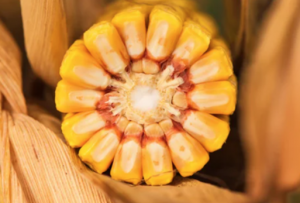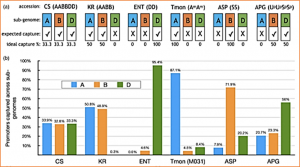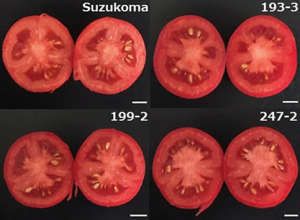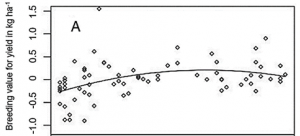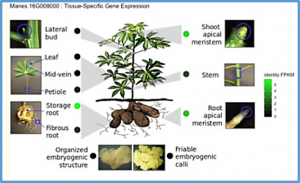Insulin-dependent or type 1 diabetes (T1D) is a polygenic autoimmune disease. In humans, more than 60 loci carrying common variants that confer disease susceptibility have been identified by genome-wide association studies, with a low individual risk contribution for most variants excepting those of the major histocompatibility complex (MHC) region (40 to 50% of risk); hence the importance of missing heritability due in part to rare variants. Nonobese diabetic (NOD) mice recapitulate major features of the human disease including genetic aspects with a key role for the MHC haplotype and a series of Idd loci
The use of hybrids is widespread in agriculture, yet the molecular basis for hybrid vigor (heterosis) remains obscure. To identify molecular components that may contribute to trait heterosis, we analyzed paired proteomic and transcriptomic data from seedling leaf and mature leaf blade tissues of maize hybrids and their inbred parents. Nuclear- and plastid-encoded subunits of complexes required for protein synthesis in the chloroplast and for the light reactions of photosynthesis were expressed above midparent and high-parent levels, respectively.
Lack of high-throughput phenotyping systems for determining moisture content during the maize nixtamalization cooking process has led to difficulty in breeding for this trait. This study provides a high-throughput, quantitative measure of kernel moisture content during nixtamalization based on NIR scanning of uncooked maize kernels. Machine learning was utilized to develop models based on the combination of NIR spectra and moisture content determined from a scaled-down benchtop cook method.
Research on a few model plant-pathogen systems has benefitted from years of tool and resource development. This is not the case for the vast majority of economically and nutritionally important plants, creating a crop improvement bottleneck. Cassava bacterial blight (CBB), caused by Xanthomonas axonopodis pv. manihotis (Xam), is an important disease in all regions where cassava (Manihot esculenta Crantz) is grown. Here, we describe the development of cassava that can be used to visualize one of the initial steps of CBB infection in vivo.
Current status on plant cytogenetic and cytogenomic research has allowed the selection and design of oligo-specific probes to individually identify each chromosome of the karyotype in a target species. Here, we developed the first chromosome identification system for legumes based on oligo-FISH barcode probes. We selected conserved genomic regions between Vigna unguiculata (Vu, cowpea) and Phaseolus vulgaris (Pv, common bean) (diverged ~ 9.7–15 Mya), using cowpea as a reference, to produce a unique barcode pattern for each species.
A data set of promoter and 5′UTR sequences of homoeo-alleles of 459 wheat genes that contribute to agriculturally important traits in 95 ancestral and commercial wheat cultivars is presented here. The high-stringency myBaits technology used made individual capture of homoeo-allele promoters possible, which is reported here for the first time. Promoters of most genes are remarkably conserved across the 83 hexaploid cultivars used with <7 haplotypes per promoter and 21% being identical to the reference Chinese Spring. InDels and many high-confidence SNPs are located within predicted plant transcription factor binding sites, potentially changing gene expression.
Enterobacter sp. SA187 is a root endophytic bacterium that maintains growth and yield of plants under abiotic stress conditions. In this work, we compared the metabolic wirings of Arabidopsis and SA187 in the free-living and endophytic interaction states. The interaction of SA187 with Arabidopsis induced massive changes in bacterial gene expression for chemotaxis, flagellar biosynthesis, quorum sensing, and biofilm formation
Sugar content is one of the most important quality traits of tomato. Cell wall invertase promotes sucrose unloading in the fruit by maintaining a gradient of sucrose concentration between source leaves and fruits, while invertase inhibitor (INVINH) regulates this process. In this study, knock-out of cell wall INVINH in tomato (SlINVINH1) was performed by genome editing using, CRISPR/Cas9 and Target-AID technologies.
Intensive systems with two or three rice (Oryza sativa L.) crops per year account for about 50% of the harvested area for irrigated rice in Asia. Any reduction in productivity or sustainability of these systems has serious implications for global food security. Rice yield trends in the world’s longest-running long-term continuous cropping experiment (LTCCE) were evaluated to investigate consequences of intensive cropping and to draw lessons for sustaining production in Asia. Annual production was sustained at a steady level over the 50-y period in the LTCCE through continuous adjustment of management practices and regular cultivar replacement.
Manihot esculenta (cassava) is a root crop originating from South America that is a major staple in the tropics, including in marginal environments. This study focused on South American and African germplasm and investigated the genetic architecture of hydrogen cyanide (HCN), a major component of root quality. HCN, representing total cyanogenic glucosides, is a plant defense component against herbivory but is also toxic for human consumption.


 Curently online :
Curently online :
 Total visitors :
Total visitors :


